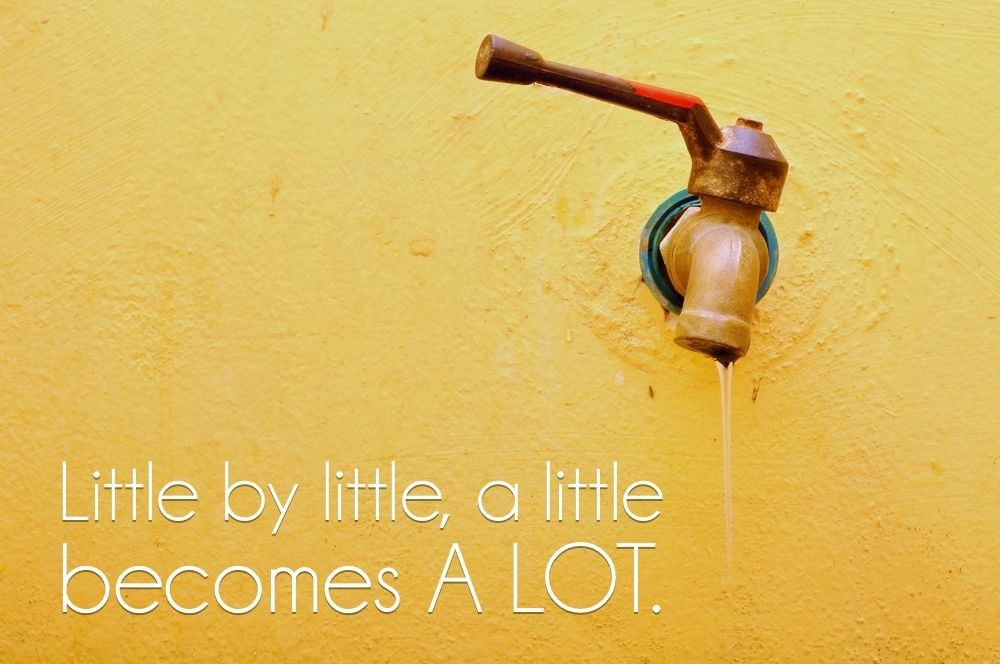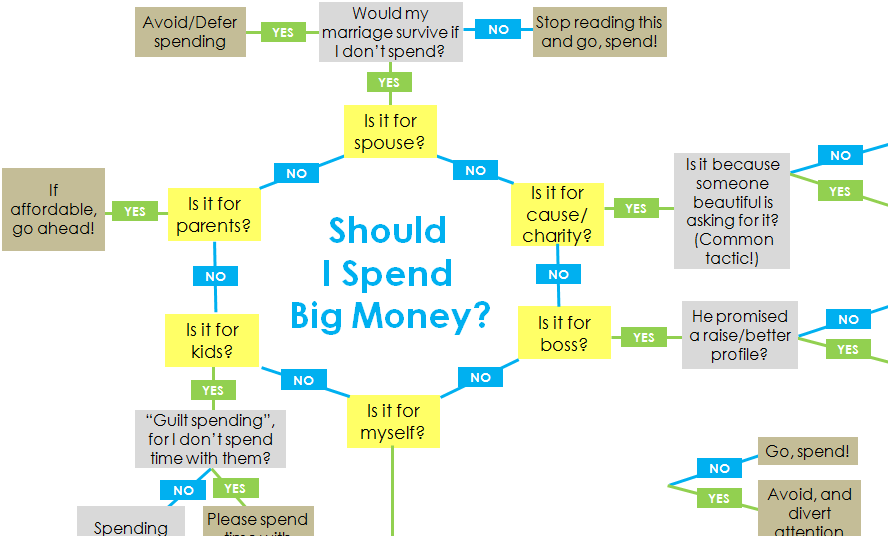Awarded the
“Rodinstar” Post
of the week!!
A three-bedroom apartment. Two cars. Enough flying miles to send an airline into losses (well almost!). Job with a foreign consulting company. Annual salary of Rs 30 lac…or around 45-times India’s average per capita income.
Yet my friend Rohan is not happy.
Whenever I meet him, he is, as I put it, caught on the “work-spend treadmill.”
So, last week when he was showing off his latest purchase, a third mobile, and one costing in excess of Rs 45,000, I told him, “Spend less money, my friend.”
“But spending money is what makes me happy,” he replied.
“You don’t have to feel deprived when you spend less money,” I said. “In fact, if you keep spending and spending even as your income rises, you’ll keep running and running and never get anywhere.”
“Why?” he asked in a state of confusion, while playing with his new toy.
“Increases in income can be like that,” I said. “Your overall level of happiness doesn’t ever progress because you just get used to the new way of life.”
He replied, “But reducing spending means giving up the good things in life, which I think is difficult to give up!”
I had made up my mind to change his, so I countered, “You see, when you start earning more money, you might drive a Honda Accord instead of a Maruti Swift, shop at Marks & Spencers instead of Hypercity, and eat at TGIF instead of Dosa Plaza.”
“Yes, that’s my point!” he interrupted.
“Indeed!” I said. “So you’ll feel a burst of pleasure when your new lifestyle is still novel but eventually you’re likely to adjust back to your baseline level of happiness, even though your spending has permanently increased.”
“In effect, you will always remain on that hedonic treadmill!”
“Now you are confusing me!” he replied, finally keeping his handset aside. “What’s this hedonic treadmill, and what do you mean I will always remain on it?”
“Well, I read about the “hedonic treadmill” a few years back,” I replied. “Wikipedia describes it as…
…the tendency of humans to quickly return to a relatively stable level of happiness despite major positive or negative events or life changes.
According to this theory, as a person makes more money, expectations and desires rise in tandem, which results in no permanent gain in happiness.
“And how do you get off this hedonic treadmill, Vishal?” Rohan asked.
“Like I did!”
“And how did you do it?”
“Using four simple rules…
- Questioning each expenditure item, especially the big ones.
- Stepping down my expectations and aspirational spending.
- Not trying to keep up with the Joneses (there’s something really satisfying about driving a modest car when you could afford a lot more!)
- Getting excited about being a cheapskate (yes, it’s a virtue not a vice).”
“Great, but what did you achieve out of that?” Rohan asked.
“Rs 25 lac in extra savings over 6 years!”
“Wow! How?”
“You see Rohan, the idea that you need to go bigger to be happy is false,” I said. “I really believe that mindless acquisition of material goods doesn’t bring about happiness.
“And thanks to my willingness to not run on this hedonic treadmill, and thanks also to the due support from my wife, here is how I have saved approximately Rs 25 lac by NOT spending on…
Bigger house in 2007 – Saving of Rs 15 Lac (that Rs 15 lac would have multiplied by 5 times till-date is another matter, but I couldn’t have afforded a bigger house then!)
- Bigger car in 2007 – Rs 5 Lac (my friends bought, so what?)
- Timeshare holidays in 2009 – Rs 2.5 lac (got lucky, as stopped payment of the cheque at the last moment!)
- Smarter mobile in 2010 – Rs 40,000 (I still use my handset only to text and call)
- Shiny tablet PC in 2012 – Rs 40,000 (someone then gifted it to me :-))
- Bright, beautiful toys for kids during 2009-2012 – Rs 50,000 (no peer pressure please!)
- High-end clothes for myself during 2008-2012 – Rs 50,000 (I look handsome in plain cotton stuff)
- Painting the house in 2010 – Rs 30,000 (my wife did it :-))
- Other ego-boosting stuff – Rs 50,000 (first pocket, then ego)
“So total savings of around Rs 25 lac!”

Image Source: Lifehack[dot]org
Rohan seemed stunned to see these numbers, and thus I continued,” You see Rohan, saving money by not spending it is just one side of the picture. I have not told you about the better, brighter side!”
“And what’s that?” he asked, now with a disturbed look on his face.
“Well, it’s that this extra saving has helped me…
- Repay the small loan on my small car
- Repay the big loan on my big-enough house
- Erase the constant fear of having someone else deciding my financial future with words like “You are promoted” or “You are fired”
- Create the confidence to pursue my passion in life
- Create great amount of time to spend with my family
- Invest extra towards my future financial goals
“So even as you continue to pay the banks 60% of your income as EMIs,” I teased him, “I don’t pay a rupee, and instead make my money work for me!
“Plus, given that I earn lesser than what I was earning on my job (while saving more), I have become even more careful in spending money. So now I don’t waste money purchasing stuff. Rather, I purchase experiences like travelling the country and enjoying time out with my family.”
“You are living a perfect life, huh!” he said, this time seemingly jealous.
“Not perfect dear, for I have my own anxieties, fears, downtimes, pains, and emotional sufferings…but then someone said that perfectionism is slow death!
“So my life is not perfect, but I surely am financially free (well almost, as I still work an hour a day for money)! And that’s a great starting point for solving a lot of a man’s problems!
“Hmm!” said Rohan while packing away the mobile handset in its box.
“Let me tell you one final secret Rohan,” I said.
“What’s that?”
“Well, since I don’t need to spend a lot of money to enjoy life, I don’t need to spend a lot of time getting a lot of money. And that’s why you can come home anytime to discuss how you would plan to come off your own hedonic treadmill.”
I then shared with him a flowchart that has helped me a lot in saving a lot of money by leading me to NOT spend a lot of money on things I now consider frivolous.
Click here or on the image below to download the flowchart. It may not be a perfect one that solves your spending problems, but it has helped me a lot in saving those “extra” Rs 25 lac over the past six years, which have helped me immensely while starting up on my own, and without any outside funding.
In the chart, start reading from “Should I spend big money?”
(Want to save the full image? Click on the image above, then right-click, then click “Save image as…”)
Let me know what you think of this flowchart, and let me also know what you are doing to NOT spend money on things you DON’T really need.
If not yet, I would love to see you get off that hedonic treadmill as fast as possible. 🙂







Sony Joseph
Getting off this “hedonic treadmill” right away Sir !! Thanks for the post 🙂
Praveen Prabhu
Hi there,
I went on a saving spree some 6 months back & reaping the benefits now.
Wish i could have got this that time, but its never too late to start saving.
Thank you for this.
Perzen Darukhanawalla
Thank you for this quick reminder on how little savings becomes a lot. I also follow this principle of “Pay Yourself First” where about 30% of my salary gets cut from my account on the day it arrives itself. It took 4 months to get used to not having so much money but have now changed my life around it. That day, I got a text about how much I had managed to put away and I was shocked!
Nitish Mehta
Just amazing ,,,!!! post is must read for under 30 entrepreneurs for sure..!!!
Sarsij Nayanam
Thanks a lot for sharing such simple yet awesome ideas 🙂
Kumar Vaibhav
Amazing write-up and completely agree with you on “hedonic treadmill”!!!
Anoop Nair
Very well written Vishal.. Really Inspiring. Thanks for sharing your story.
Manish Singh Bisht
Hedonic Treadmill… Nice post.
Image I got after saving is not full. Is it a tech issue?
Surabhi
Thanks for sharing, I liked the way you explained everything. I was spending a lot but by now I will think about some money for myself.
Nidhi Kukreja
awesome read !!
first few lines inspired me and i just saved my 25K, thanks =)
my investments are on sip modes, so within first week money starts working for me =))
Pawan Deokule
Hedonic Treadmill: The American version of the Indian Buddhist theory of frugal denouncement to attain happiness!
You can only hold as much land that you step on, to hold more land you must control people who step on the remaining land!
Nicely explained for young entrepreneurs who tend to fall prey to visual fictional pleasures.
Mitul Limbani
I can relate this to Rich Dad, Poor Dad story 😉
Identifying ASSETS vs LIABILITIES and decide which ones to ABSOLUTELY SPEND (if they ever fall in the LIABILITIES Quadrant)
Sridhar V
Hi Vishal,
This is practical advise for people who are wasting cash on decaying assets. But for those like me who already know about these and are prudent, the only route is to make additional income though extra work, investments, etc.
But I would say that I have missed out on some aspects above in the past, despite being prudent on expenditure. So there is always scope for improvement. In today’s volatile employment market its absolutely indispensable to have additional streams of income and back-ups to keep afloat……..Im sure people from non-IT sectors know this.
I’m in full agreement to the suggestions given by you. A few ideas or things that i used to do are below:-
Invest extra towards my future financial goals: This is important. Most people think investing is like investing in equities/stocks/mutual funds, which is quite narrow. Another set of people who hate Equities stick to fixed deposits, thinking they are smart savers. The better approach is to use a mix of financial products/investment avenues to distribute or manage your risk. Most people dont have an idea of ‘why to invest’ because it is believed that the only way to get ahead is to work more, earn more, spend more and so on. Sorry to say, today’s economic realities are different, and few people succeed in this Rat Race or Hedonic Treadmill as mentioned above. Slowdown or jobless economic growth is here to stay….and pink slips, pay cuts, layoffs, etc are common (not only for nonperformers but can hit any one including the best performers). The only way to de-risk from these situations is to build an additional stream of income and back up in the form of assets. Whatever be your future financial goal – marriage, education, home purchase, retirement, etc…..once the income tap dries up you may not be able to manage day to day expenses, so goals become out of sight. Instead if one plans today and invests for future, a consistent and steady stream of incomes and assets can be built for the future.
Sugumaran Uppili
Oooph Man!! Thats one article that was very timely. I love the chart. Especially ” Really ? Answer this after thinking 10 days”. There is the trick.
Amol Ghemud
great read…thanks for sharing
Kunal Bajaj
I don’t know if it’s a coincidence or it was meant to be. I was actually thinking on saving money or eradicating extra expenses and i came across this. Thanks a lot Vishal. Looking forward to more in financing space 🙂
yuvraj wadhwani
Interesting article which should be taught in schools as common sense. A little frugality and delayed gratification will help generations to come 🙂
shobhan d
Quite aptly put, a great lesson for the younger generation.
Vishal Khandelwal
All the best, Sony! 🙂
Vishal Khandelwal
My pleasure Praveen. Thanks!
Vishal Khandelwal
Most people follow the equation of “Income – Spending = Saving”. But what really works is what you are doing Perzen…”Income – Saving = Spending”. All the best!
Vishal Khandelwal
Thanks Nitish!
Vishal Khandelwal
Thanks for reading, Sarsij!
Vishal Khandelwal
Thanks Vaibhav!
Vishal Khandelwal
My pleasure Anoop. Thanks for your feedback!
Vishal Khandelwal
The image is complete, Manish Thanks for your feedback!
Vishal Khandelwal
All the best in your saving endeavour, Surabhi! 🙂
Vishal Khandelwal
Great start, Nidhi. 🙂 All the best!
Vishal Khandelwal
Thanks Pawan!
Vishal Khandelwal
Thanks Mitul! Yes, RDPD is an amazing book to learn the core and most important yet basic ideas in personal financial management.
Vishal Khandelwal
Invaluable ideas, Sridhar! Thanks for sharing!
Vishal Khandelwal
Indeed Sugumaran 🙂 All the best!
Vishal Khandelwal
Thanks for reading, Amol!
Vishal Khandelwal
🙂 Thanks Kunal!
Vishal Khandelwal
I hope so, Yuvraj! 🙂
Vishal Khandelwal
Thanks Shobhan!
asha chaudhry
hi vishal,
pls check the top of your post!
🙂
Vishal Khandelwal
Thanks Asha 🙂
Sanjay Shenoy
Really nice post.
I am trying to move towards something very similar but much more austere approach the 80 : 20 rule. Save the 80% spend the 20% . Now it might seem a bit too harsh but what I am trying to do is if I want to spend more then I have to increase the quantum of that 20% rather than taking some money from the 80%. That means I work harder try to earn more and then spend more but still be spending only 20% of my earnings.
I recently bought a note 2 and within a couple of months I realized how useless it is to have such an expensive phone. It does everything a normal phone does and has features that I hardly use for which I paid premium. That’s when I realized I need to stop spending like an idiot and try saving something.
Kunal Bhusare
Am so glad, you have put these concepts in words.
My friends considered me miser when I refused to spend on few frivolous things, am happy to see myself practising an important trait, unknowingly !
Jamsheed Gandhi
bang on!!! really well defined and communicated!!!! this is coming from a person who totally lives and relates to what you are saying.
Naveen Lawrence
Thanks Vishal for the post….Its really amazing…!!
jolly jose
Thanks Vishal for this piece of very useful advice. How often we hear this statement – ” If I had to do this start up again, I would have used my learnings and I wouldn’t have spend so much and saved on costs ” But more often than not , we think of these extra spend we did m, only on Hindsight.
Sushrut Munje
How awesome this post is! 😀